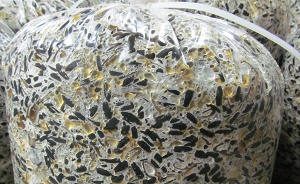
And why condensation under the bag is not always a bad sign - we'll talk about that too🤓
Many beginners rush to lower the temperature right after incubation ends, but this stage is more delicate than it seems.
In this article, I’ll walk you through how to cool down your blocks correctly — and whether you should be worried about that foggy moisture under the plastic.
Once incubation is over and the blocks are fully colonized with white mycelium, it’s time to prepare them for fruiting. One of the key triggers for fruiting is a drop in temperature. But if you cool the blocks too quickly, it can backfire.

Take a look at this photo — the block is fully colonized and looks healthy overall, but see that dark spot in the upper right corner?
It appeared because cold air from the AC unit was blowing directly on that area.
The trick is to lower the temperature gradually — both in the room and inside the blocks themselves.
A slow drop mimics natural conditions and avoids stress on the mycelium.
💡Note:
The first two methods can also help you maintain air temperature in the incubator during block colonization.
But if you’re using them to cool blocks before fruiting, make sure you're working with a single-zone setup or that all blocks in your incubator are the same age.
📌Don’t forget that at this stage you also need to change all other parameters — here’s a detailed article on that.
Here are a few methods that work well:
Option 1: Gradual cooling inside the incubator
If you have a climate-controlled room, simply lower the temperature in small steps — about 1–2°C (2–4°F) every few hours. You can use an air conditioner and reduce the setpoint slowly.
Option 2: Bring in fresh air (carefully)
If the air outside is cooler than inside the incubator, open the fresh air intake just a little — no more than 5% at a time — while reducing recirculation accordingly. This helps avoid condensation caused by sudden temperature drops.
Option 3: Use an intermediate room
If you’re working with a two-zone setup, you can move the blocks from the incubator to a room that’s a few degrees cooler (around 16–17°C / 60–63°F). After a day or two, when the internal temperature drops, you can transfer them to the fruiting room.
Avoid using cold air directly on the blocks. A sudden drop of 5–6°C (10–11°F) in 30–40 minutes often causes water to form between the substrate and the bag — and that leads us to the next section.
Many growers see water droplets inside the bag and assume something’s wrong. But here’s the thing: condensation doesn’t always mean contamination.
Oyster mushroom mycelium is alive. It breathes, produces heat, and releases moisture — especially during the early days of incubation when it's working hard.

So some fogging or droplets on the inner surface of the bag are totally normal.
In fact, a little condensation can mean your mycelium is active and healthy.
By the way, here’s a fun little side note about those golden-brown liquids and mycelial metabolites.
In English-speaking grower groups, I’ve come across the term “mushroom pee” — and at first, I was honestly surprised!
It’s not something we say, but it kind of makes sense when you think about it. These metabolic byproducts can sometimes look like strange colored droplets, especially when they build up in the corners of the bag.
Sure, it’s mostly just excess water tinted by straw pigments and mycelium waste products — but still, it’s funny what names people come up with.
I’ve seen recommendations to cut off the corner of the bag when liquid starts collecting there. If you do that, just place a small container underneath — no need to let it drip straight onto the floor.
That liquid might already have some bacteria growing in it, so it’s better to keep things clean.
If the heat treatment of your substrate was poor or uneven, excessive condensation can encourage mold or bacterial contamination. Especially if the water pools in pockets or causes the mycelium to stall.
The danger also increases if the room is too hot or the bags are packed too tightly and touching — that’s when overheating starts.
If you’re seeing moderate condensation but the blocks are colonizing evenly and smell fine, don’t panic. Keep the room temperature stable and ensure there’s gentle air movement (recirculation, not outside air).
Let the bags do their thing.
If you’re seeing dark spots, green mold, or a sour smell — that’s a different story. You may need to reassess your heat treatment or look into contamination management (I’ve got a separate article on that).
Cooling and condensation are natural parts of the growing cycle — you just need to know what’s normal and what’s not. Keep things gradual, steady, and clean, and your mushrooms will thank you.
